#laramidia
Text
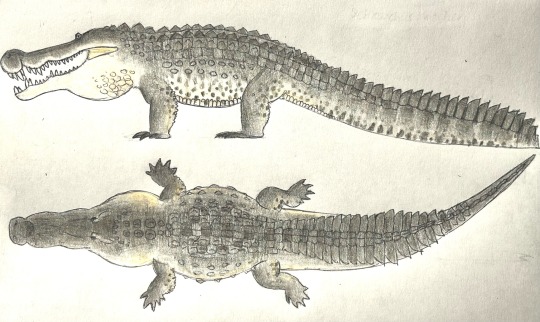
Hatcher’s Terrible Crocodile
Color-Pencil impression of Deinosuchus hatcheri, a giant 10.6 to possibly 13-meter-long crocodilian that terrorized North America’s coastal floodplains during the Campanian age (82-73 million years ago) of the Late Cretaceous.
#paleoart#paleontology#deinosuchus#crocodylomorpha#crocodilian#late cretaceous#campanian#laramidia#deinosuchus hatcheri#cretaceous#cretaceous period
57 notes
·
View notes
Text

Big deal...you got your life guard certificate...Allosaurus still rules dude...
#dinosaur#dinosaurs#science#paleontology#prehistoric#prehistoric planet spoilers#prehistoric planet 2#prehistoric planet#trex#late cretaceous#cretaceous period#tyrannosaurus rex#theropod#fossils#north america#laramidia#tyrannosaurid#bipedal#carnivore
4 notes
·
View notes
Text
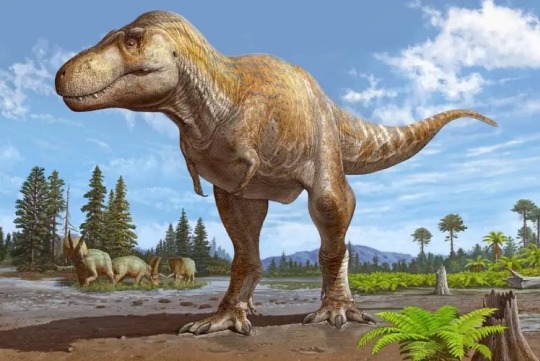
well, it seems a new Tyrannosaurus species was described today! the paper, (authored by Sebastian G. Dalman, Mark A. Loewen, and Nicholas R. Longrich) is based on remains from ancient Laramidia (now New Mexico) previously attributed to T. rex. These particular fossils are dated 6-7ish million years before T. rex. This newly proposed species, Tyrannosaurus mcraeensis, will hopefully give some insight into the evolution of T. rex, which has largely been shrouded in mystery.
The working theory has been migration from what is now Asia, *but* if T. mcraeensis continues to hold up to scrutiny it would turn out that the reverse is true! or even that a double back migration saw large tyrannosaurine dinosaurs migrate to Asia, only to migrate once again towards the northern part of North America!
Obviously the paper goes into far more detail, so i’ve included it below. give it a look!
(art at the top of the post was made by Sergey Krasovskiy)
#paleoart#dinosaurs#palaeoblr#dinosaur#paleontology#mesozoic#Tyrannosaurus mcraeensis#Tyrannosaurus rex#T rex
1K notes
·
View notes
Text
On Navajodactylus


Two depictions of Navajodactylus as a non-azhdarchid pterodactyloid, by Spooky and Corvarts respectively.
Navajodactylus boerei is an interesting Late Cretaceous pterosaur from the Campanian of the San Juan Basin (then part of Laramidia). Represented by a single ulna, it was tentatively attributed to Azhdarchidae when first discovered, and indeed specimens attached to the genus found in Canada were transfered to the azhdarchid Cryodrakon boreas. However, the original specimen has no features attributed to Azhdarchidae, and indeed Mark Witton is not convinced it belongs to this clade (Witton 2013).
This means that Navajodactylus is an example of a non-azhdarchid pterosaur from the Late Cretaceous, though further studies will need to be made. Personally, I think it is a ctenochasmatoid based on two criteria:
Coupled with how scarce pterosaur remains are, a ctenochasmatoid ghost lineage enduring to the Late Cretaceous is plausible, if needing more work.
Until then, this goober should be considered quite a remarkable animal
66 notes
·
View notes
Text
A lonely Kosmoceratops wades through the waters of the marshy Kaiparowits jungle. It's the Campanian and present-day southern Utah is a steamy coastal jungle on the continent of Laramidia. In the background, the foraging of a pair of Mirarce is disturbed by something in the distance. Alphadon peers at the wandering ceratopsian from its perch on a fallen cypress, near the remains of a Deinosuchus. The flora also includes cycadeoids, bennetites, equisetum, small generic flowering angiosperms, magnolias, and ferns.

#illustration#paleoart#paleontology#natural history#science#dinosaurs#sciart#vector illustration#ceratopsidae#ceratopsian#late cretaceous
277 notes
·
View notes
Text
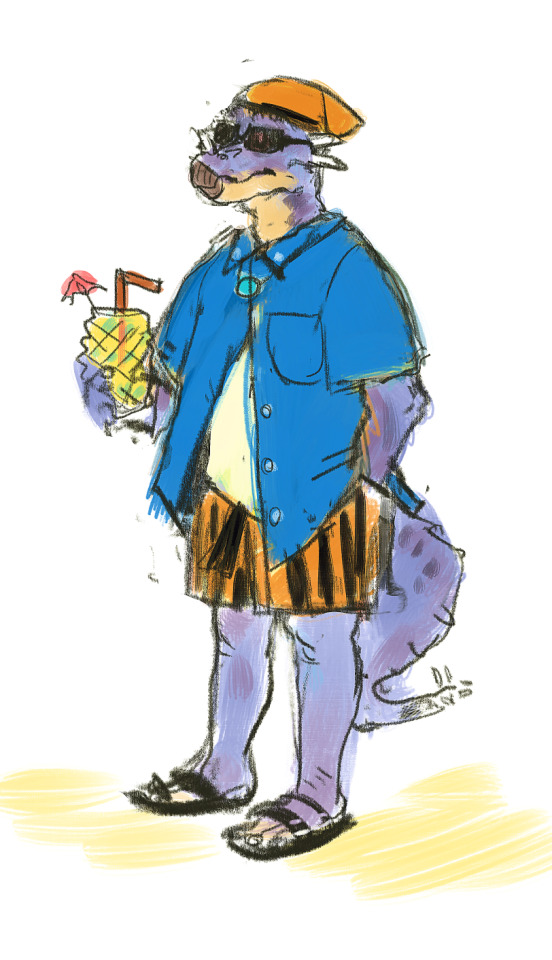
don't bother me, i'm offline in Laramidia
#drawing#doodle#sketch#art#dinosaur#saurian#ankylosaur#anthro art#furry art#anthro#furry#dynasoar5#ssohardd#summerheads
116 notes
·
View notes
Text
A giant tyrannosaur from the Campanian–Maastrichtian of southern North America and the evolution of tyrannosaurid gigantism
Published 11th January 2024
Discovery of a new tyrannosaurin, Tyrannosaurus mcraeensis, based on a fossil from the Hall Lake Formation of New Mexico previously referred to as Tyrannosaurus rex. Tyrannosaurus mcraeensis predates Tyrannosaurus rex by ~ 6–7 million years, yet they were similar sizes, Phylogenetic analysis leads to Tyrannosaurus mcraeensis as sister to Tyrannosaurus rex and indicates that Tyrannosaurini originated within southern Laramidia.

Locality and stratigraphy of Tyrannosaurus mcraeensis, reconstruction of cranial elements and silhouette; Cranial elements of Tyrannosaurus mcraeensis holotype
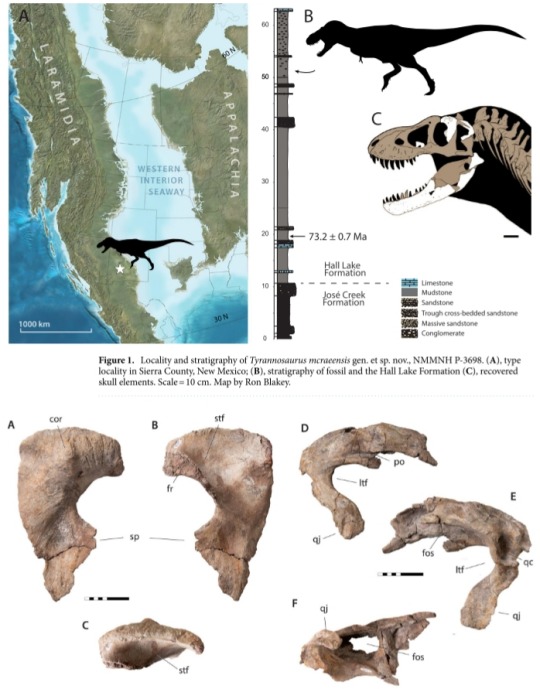
Mandibular elements of Tyrannosaurus mcraeensis holotype
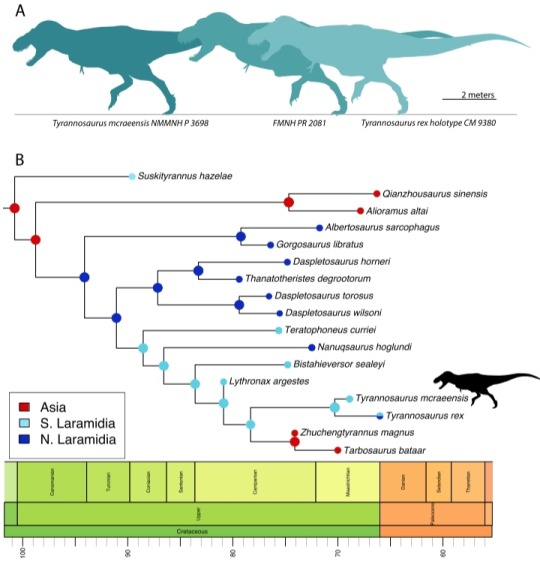
phylogenetic anaylsis of Tyrannosaurus mcraeensis
Source:
(I'm back from a break, enjoy reading this great publication! It took a few years to make so support the team who worked on this and click on the link if you're interested.)
#paleontology#fossil#prehistoric#extinct#science#dinosaur#dinosaurs#new species#tyrannosaurus rex#tyrannosaurid#t rex#Tyrannosaurus mcraeensis
20 notes
·
View notes
Text
Time for a quick big-brain thought
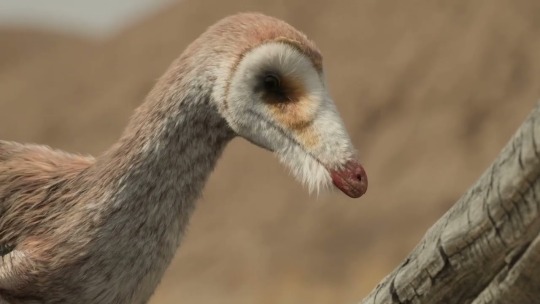

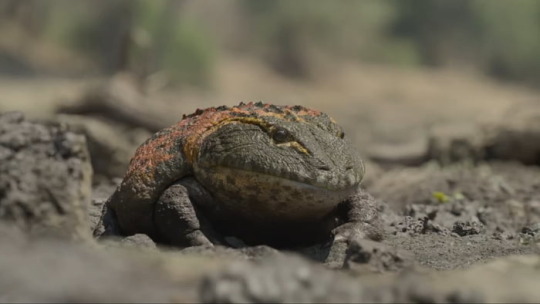

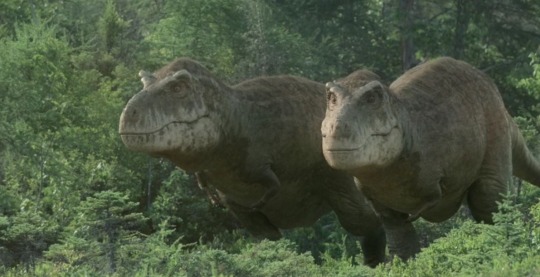
I know that I’ve made an entire hypothetical scenario for how a third PHP season would go last year, along with how the series itself hasn’t mentioned in any major announcements as of late, but what if this hypothetical third season had a major theme with its episodes?
As in, instead of using habitats as the themes, why not go with entire locales instead? Maybe this could be the show going back to some of its most famous settings before closing things out, but I feel like having future episodes focus on an entire location instead of a single biome in general could be an interesting way to deal with running out of compatible habitats. Hell, it could be a good way to not only introduce new species, but also bring back certain animals from past episodes. I know this is a little bit far fetched, but hear me out.
Nemegt (Basically the Nemegt Formation and the surrounding area)
Old Species- Tarbosaurus, Mononykus, Deinocheirus, Tarchia, Prenocephale, Barsboldia
New Species- Gallimimus, Udanoceratops, Saurolophus, Conchoraptor, Adasaurus, Brodavis
Patagonia (The southern part of South America, with places like the Allen, La Colonia, and Cerro Fortaleza Formations being found there. Areas like Chile could also fit)
Old Species- Carnotaurus, Dreadnoughtus, Austroraptor, Secernosaurus, Mortuneria (if we wanna continue with the idea of them being South American residents)
New Species- Maip, Stegouros, Aerotitan, Gondwanatherium, Sektensaurus, Noasaurus
Madagascar (Basically what it says on the tin)
Old Species- Majungasaurus, Rapetosaurus, Beelzebufo, Simosuchus, Adalatherium, Masiakasaurus, Madtsoia
New Species- Facatakely, Mahajangasuchus, Sahonachelys, Rahonavis, Vintana
Tethys (The European archipelago and surrounding sea, with places like Hateg Island, France, and even a small bit of Morocco being examples)
Old Species- Hatzegopteryx, Zalmoxes, Mosasaurus, Telmatosaurus, Barbaridactylus, Diplomoceras
New Species- Squalicorax, Ampelosaurus, Ocepechelon, Gavialimimus, Gargantuavis, Rhabdodon
Laramidia (Yes, I am aware that this could be like “North America” again, but with place like Hell Creek, Prince Creek, Ojo Alamo, and even parts of the inland sea that was still present at the time, there’s plenty of material to work with, even moreso than NA)
Old Species- T. Rex, Triceratops, Quetzalcoatlus, Alamosaurus, Edmontosaurus, Pachycephalosaurus, Pectinidon, Pachyrhinosaurus, Nanuqsaurus, Prognathodon, Hesperornis, Xiphactinus
New Species- Ankylosaurus, Anzu, Habrosaurus, Lonchidion, Thescelosaurus, Borealosuchus, Basilemys, Didelphodon, Bravoceratops, Bonnerichthys, Hydrotherosaurus
Is this a rather odd and ridiculous idea for a third PHP season that might not happen? Yes, yes it is. But, like with my of my other ideas and projects on here, it’s one that I wanna share to get input on.
6 notes
·
View notes
Text
Tyrannosaurus – Tyrant King
Tyrannosaurus rex, Tyrannosaurus regina, and Tyrannosaurus imperator.
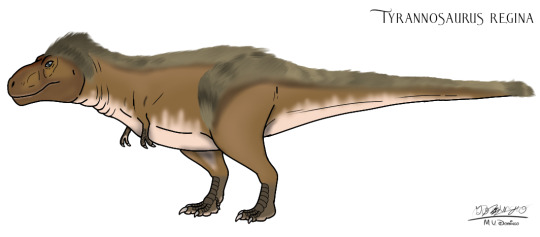


“ Ah, yes. The 'tyrant lizard'. The Tyrannosaurus rex. Favorite of early century fiction writers and adolescent children everywhere. And why? Because it represents everything we fear about the past. It's what we believe that we've conquered, even though it ceased to exist before humanity had reached the proto-ape stage. And that was true. Until now. Until you. ”
— Dr. Ian Malcolm
Tyrannosaurus is the extinct genus of large theropod dinosaur lived throughout what is now western North America, on what was then an island continent known as Laramidia. Tyrannosaurus had a much wider range than other tyrannosaurids.
All species of Tyrannosaurus walked the Earth, there would have been a total of some 2.5 billion adults that ever lived. But even Dr. Marshall thinks the 20,000 number is likely low. “It just seems inconceivable you can last a couple of million years with those few individuals,” he said.
Reference
https://www.nytimes.com/2021/04/15/science/tyrannosaurus-rex-population.html
https://en.wikipedia.org/wiki/Tyrannosaurus
https://www.deviantart.com/ognimdo2002/art/Tyrannosaurus-Rex-855512588
2 notes
·
View notes
Text

Impressions top to bottom of the there main species of the centrosaurine ceratopsid Pachyrhinosaurus, which lived in northern Laramidia 73-68 million years ago: P.canadensis and P.lakustai from the Horseshoe Canyon Formation, and P.perotum from the Prince Creek Formation of Alaska.
#pachyrhinosaurus#dinosaur#paleoart#dinosaurs#paleontography#paleontology#cretaceous#cretaceous period#cerstopsian
112 notes
·
View notes
Text
Nuova specie di tirannosauro gigante scoperta nel Nuovo Messico
Ricostruzione artistica di Tyrannosaurus mcraeen.
La scoperta di Tyrannosaurus mcraeensis, una specie sorella del famoso Tyrannosaurus rex, suggerisce che i dinosauri tirannosauridi hanno avuto origine a Laramidia, un continente insulare che esisteva tra 100 e 66 milioni di anni fa e si estendeva dall’odierna Alaska al Messico.
“I dinosauri tirannosauridi erano i predatori dominanti in Nord…
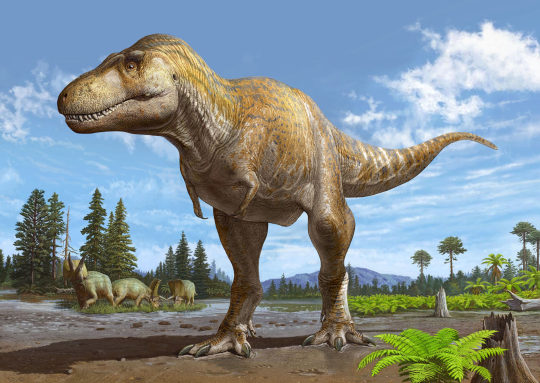
View On WordPress
0 notes
Text

On This Date 128 Years Ago … Utah became a state. Like elsewhere across the Americas, it was once home to a wide array of dinosaurs as part of an island landmass some 75 million years ago known as Laramidia. Photograph By Cory Richards
0 notes
Text
Multituberculate Earth: Ptilodontoidea
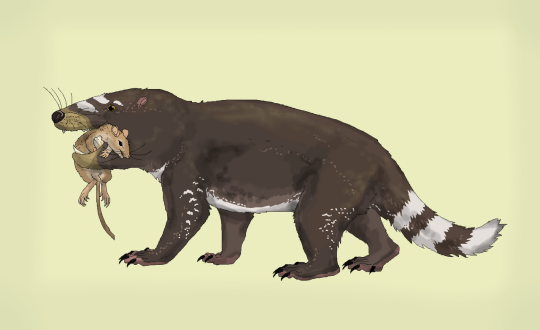
Ptilodontoidea is one of the best understood of all multituberculate clades, in part because it has the first multituberculate described, Ptilodus medieavus, in part because there are quite a few complete specimens, in part because they were highly successful and the last multituberculates to exist (barring possibly gondwanatheres). They first evolved in the island continent of Appalachia, but were quick to disperse to Laramidia where they quickly became the dominant mammals. Their success skyrocketed in the Paleocene, where they are the period’s most common mammal fossils, and even after the decline of multituberculates as a whole several genera lasted into the Eocene, only dying out at the end. These last ones were mostly generalistic carnivores, making the claim that multituberculates were outcompeted by rodents even more questionable.
In this timeline, their fall never comes. Well, it does, but its more complicated.
In the Paleocene, ptilodontoideans radiated much as in our world. They produced a myriad of arboreal forms, being the dominant mammals across the northern hemisphere’s canopies. They were also the first multituberculates to produce raptorial forms, with leopard-sized predators stalking the northern forests. One lineage made it to South America, and soon made their way to Antarctica and then Australia; these, however, remained with a relatively low species diversity due to competition from dryolestoids.
The PETM was pretty severe for ptilodontoideans, which being both arboreal and leaning towards carnivory were right in the bullseye as forest ecosystems collapsed. Luckily once the rainforests covered the earth from pole to pole ptilodontoideans thrived, though in North America they lost the role of apex predators to microcosmodontids. In Europe, by contrast, they remained the top dogs, and in Asia both groups co-existed, with ptilodontoideans attaining massive sizes as some of the largest mammalian land carnivores of all time, weighing over a ton.
During the warm conditions of the Eocene ptilodontoideans diversified in a myriad of ways. Some rafted to Africa from Europe, quickly expanding without competitors in the canopies, much as primates did in our world; soon, they would raft to Madagascar and to South America. Meanwhile, one lineage developed the ability to fly, being among the several mammal lineages to do so in the favourable climes of the Eocene.
Come the Grande Coupure, and ptilodontoideans once again suffered heavy losses due to their arboreality and/or carnivorous tendencies. They were very much unable to survive the collapse of forest environments in the northern hemisphere and the arrival of competitors from Asia in Europe, so virtually all except the flying pteroectypodids and a few relictual forms in South and Southeast Asia and the Caribbean remained. By contrast, ptilodontoideans in Africa were barely affected at all, though in South America there was a faunal turnover, with the recently arrived afroptilodontoideans outcompeting the more omnivorous notoptilodontoideans, which became increasingly carnivorous in response to this, turning competitors into prey.
Ptilodontoidean history thus far has been nothing if not convoluted and full of heavy losses. But the group keeps on thriving one way or another, too sturborn and dramatic to pass on yet another glorious return.
Though not all ptilodontoideans are arboreal, they are the group that most heavily specialised to arboreal ecologies, having specialised ankles that allow greater mobility when climbing, prehensile tails and opposable thumbs. With Cretaceous forms already displaying complex social behaviours its no wonder that they are highly intelligent, their arboreal and in some cases volant lifestyles further encouraging larger and more complex brains. Their plagiaulacoids are proportionally among the largest and indeed most species lean towards carnivory, using this tooth much as our carnivorous therians use their carnassials; however, a number of species are instead seed eaters or frugivores, using this tooth instead fo crack open seeds. They generally avoid folivorous niches, being less capable of processing complex plant matter than other groups with the giant plagiaulacoids taking space reserved for grinding molars; this has put them at disadvantage with microcosmodontids and eucosmodontids, which are more omnivorous and thus adaptable.
Notoptilodontoidea
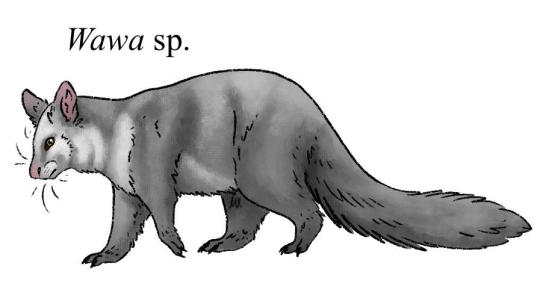
A genus, Wawa, occurs in the Santa Lucía Formation of the Paleocene of Bolivia. This is the first member of a successful clade of ptilodontoideans that would go on to spread across the southern continents much like marsupials did in our timeline – though unlike marsupials they would remain initially constrained due to competition with dryolestoids. Notoptilodontoideans are notable for the conversion of the third lower premolar – a vestigial peg-like plagiaulacoid in front of the main one – into a canine-like tooth, allowing them to use it for a variety of purposes from displaying to stabbing prey.
Initially occupying generalist and durophagous omnivorous niches akin to those of our world’s polydolopiforms, everything changed when afroptilodontoideans crossed the Atlantic to South America. These invaders were more efficient at the omnivorous niches, displacing the more generalised notoptilodontoideans as typical for competitive exclusion. However, this instead prommoted increasingly carnivorous habits in the group, and with the influx of new prey (both afroptilodontoideans and other recent arrivals like boffiids) new predatory forms had room to evolve.
Things remained much the same in Australia and Antarctic, neither of which having an influx of afroptilodontoideans. However, Antarctica’s polar forests are less capable of sustaining as much biodiversity as in the warmer north, so notoptilodontoideans compete increasingly harder with local dryolestoids. For now, neither seems to have the advantage, with notoptilodontoideans being capable of durophagy but less competent at omnivory and dryolestoids more successfully omnivorous but less capable of feeding on harder food stuffs. Time will tell which strategy will succeed, if any at all…
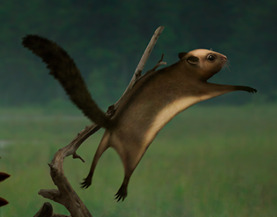
Gliding notoptilodontoidean Balanara kubbadang, fleeing from an angry Wilaru (see full picture), by Julio Lacerda. The picture was commissioned long before this project, and this was meant to be the mysterious Australian mammal Yingabalanara, but I decided to transplant the picture to my project and it fits well as a ptilodontoidean multituberculate.
Pteroectypodidae
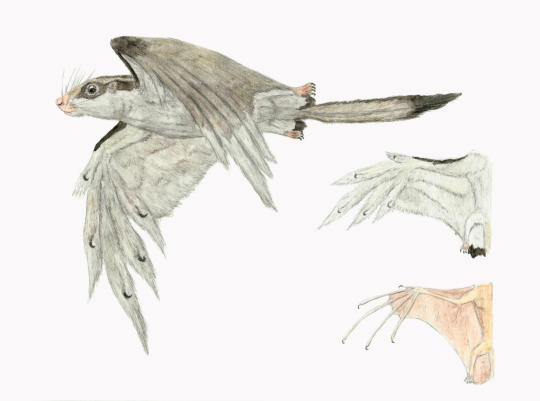
Ptilodontoideans have dominated the tree canopies of the Cenozoic, so naturally they are in a vantage position for the acquisition of flight. Many genera from the Palaeocene and Eocene have developed gliding, though most of these gliding lineages are unrelated and short lived.
The first true flyer is Pteroectypodus falco, from the Ypresian of North America and Europe. Like gliding ptilodontoideans it had patagia (albeit rather simple one with few tendons for contracting and expanding it) and converted its tarsal spur into an uropatagium support similar to the bat calcar, but instead of fully membranous wings its wing fingers and membranes supported tightly packed quills, forming an airfoil unlike any seen before. This “feathered” wing was further maintained by skin secretions, keeping the wing surface consistent even as individual hairs fell or were replaced. The wing fingers themselves were clawed and were probably still used to climb and perhaps catch prey.
How this unique arrangement came to be is unclear, but it is thought that it evolved from ancestors with a sifaka-like arm integument. In these animals, elongated hairs form an airfoil, with only patagia at the base. These allow them to prolong their jumps and even parachute to a limited degree. The ptilodontoidean aeronauts weren’t probably exactly sifaka-like in behaviour, being carnivores, but the principle remained the same, with elongated hairs forming the distal part of the airfoil. Cat-like motions to subdue their prey were the predecessors to the flight stroke. Eventually, with a large enough airfoil these arboreal predators could generate lift and took to the skies.

Morrigania centepeia, an Oligocene pteroectypodid. Notice shorter fingers, reverting back to a proper paw. The wing is now mostly composed by the stiffened quills, still attached to each individual digit and still manipulated by its flexitions. At twoo meters wingspan, this is one of the largest members of its group. By Dave Garcia
Pteroectypodids survived the Grand Coupure more successfully than other ptilodontoideans thanks to their ability to fly, allowing them to easily recolonise the remaining northern hemisphere forests and even compete successfully against new waves of tree climbers like eucosmodontids and microcosmodontids as well as birds. By this timeline’s flying mammal standards they are relatively modest, the largest species not larger than a raven, but they have successfully expanded into several niches, including omnivores, hawking insectivores, raptorial predators and even woodpecker analogues feeding on grubs by gnawing on wood with their plagiaulacoids.
They are among the world’s most intelligent mammals due to a combination of neurological pressures for powered flight and social habits, and have raher dexterous fingers. I wonder where this could lead…
Afroptilodontoidea

Having rafted from Europe to Afro-Arabia in the Eocene, ptilodontoideans found themselves with the canopies basically to themselves, neither kogaionids or galulatheriids being decent climbers (though the former got better as ptilodontoidean prey thrived). Soon they rafted to Madagascar, where the situation was much the same, and then to South America and the Caribbean, where they displaced other ptilodontoideans and leading them to adopt more unusual niches.
Compared with other ptilodontoideans, afroptilodontoideans are more enthusiastic herbivores (which is not saying a lot, since they have not developed actual leaf eaters, a niche always occupied by other contemporary groups; at most they only opportunistically take flowers and very young buds), several forms being frugivorous, nectivorous, sap-drinkers, granivores (becoming in fact the main seed-eaters in Africa and Madagascar due to the absence of mouse-like eucosmodontids) and even bark-eaters. They also enthusiastically compete with other mammals for aye-aye like niches, eating grubs by gnawing on bark with their plagiaulacoids (sometimes also going for the bark itself). In the Caribbean, they have uniquely filled the role of apex predator. Uniquely, they lost the peg-like relictual plagiaulacoid in front of their main one, which still remains proportionally large.
With few exceptions, most of these animals are highly gregarious and colorful, taking full advantage of color vision and frequently bearing structural colors like those of the mandrill. Troupes move across the canopies of Africa, South America, the Caribbean and Madagascar, howling loudly as they search for food or fight with other troupes.
Caribboptilodontoidea
A lineage of small ptilodontoideans rafted from North America to the Caribbean in the Eocene. While some filled arboreal omnivorous niches akin to their cousins elsewhere, a number took advantage of the absence of microcosmodontids, eucosmodontids and kogaionids to become terrestrial insectivores. Basically, the multituberculate analogue of a Solenodon.
These would turn out to be the winners, as afroptilodontoideans rafted their way into the Caribbean in the Oligocene, not only displacing them from omnivorous arboreal niches but from carnivorous ones as well. As such, now these animals scurry the forest floors at night, hunting whatever small animals they can find on the ground.
Like notoptilodontoideans the caribboptilodontoideans tend to be solitary. They lack the plagiaulacoid tusks but do screech a lot, bearing their long incisors and massive (fourth premolar) plagiaulacoids. Like most multituberculates they bear tarsal spurs, and in their case they possess an especially potent venom, using it mostly to stun rivals but also predators like their afroptilodontoidean cousins.
#multituberculate#multituberculate earth#multituberculata#speculative zoology#speculative biology#speculative evolution#spec evo
3 notes
·
View notes
Text
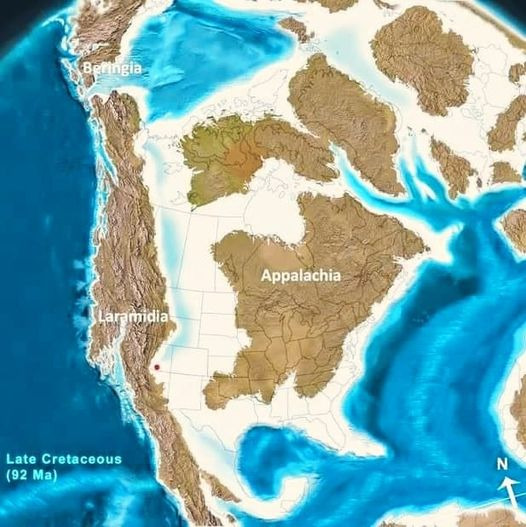
Durante el período del Cretácico tardío, Norteamérica era un continente muy diferente a como lo conocemos hoy. ¿Sabías que estaba dividida en varias regiones geológicamente y biológicamente distintas?
1. Apalaches (Appalachia): Esta región, era una isla separada del resto de Norteamérica por un mar somero conocido como el Mar de Niobrara. Estaba poblada por dinosaurios únicos y tenía un ecosistema diverso.
2. Beringia: Conectaba Asia con Norteamérica, era crucial para el movimiento de especies entre los dos continentes. Durante el Cretácico tardío, era una ruta importante para la migración de dinosaurios y otras especies.
3. Laramidia: La parte occidental de Norteamérica, conocida como Laramidia, era una isla que se extendía desde lo que hoy es México hasta Alaska. Este lugar era un verdadero paraíso para los dinosaurios, con una increíble diversidad de especies, algunas de las cuales solo se encuentran en esta región.

- El Mar Interior Occidental dividía el continente, creando estos distintos ecosistemas.
- Laramidia era hogar de famosos dinosaurios como el Tyrannosaurus rex y el Triceratops.
- La fauna y flora de Appalachia eran muy distintas a las de Laramidia.
0 notes
Text
Look all I want is a super-realistic multiplayer PvE survival/exploration sandbox game with all of the character customization options where I play a time-traveling colonist in Maastrichtian Laramidia and I progress in the game by observing the fauna and collecting samples for scientists and stuff and live in a sweet secluded cabin and also I can be left handed and customize my various guns and tools and stuff and the animals all act like real animals and not video game monsters, is that so much to ask.
0 notes